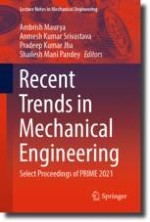This book contains the select papers presented at the International Conference on Progressive Research in Industrial & Mechanical Engineering (PRIME 2021), held at the National Institute of Technology (NIT) Patna, India. The book discusses various aspects related and relevant to core areas of mechanical engineering including engineering design, production engineering, industrial engineering, automobile engineering, thermal and fluids engineering, mechatronics, control and robotics and other inter-disciplinary emerging topics for potential use in a spectrum of applications. The book will be a valuable reference for students, researchers and professionals interested in mechanical engineering and allied fields.
